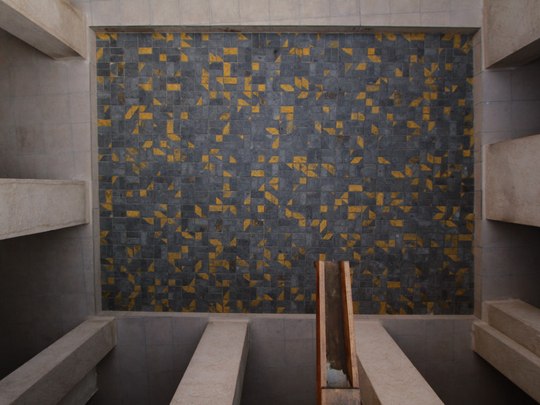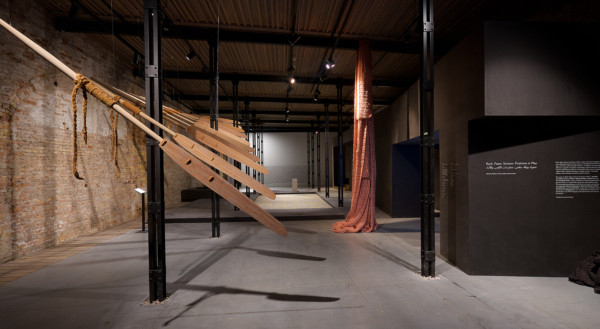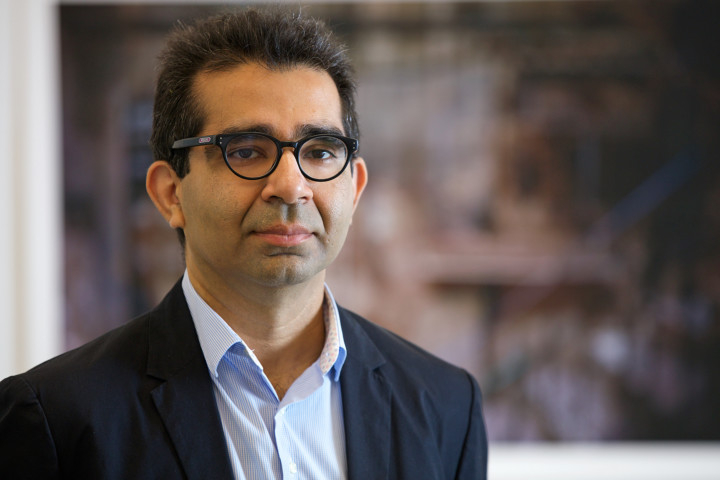
The 57th International Art Exhibition la Biennale di Venezia (Venice Biennale) opened in Venice on May 13 and will run until November 26. The event, which dates back to 1895, is the oldest and most prestigious non-commercial contemporary art exhibition in the world and is expected to attract over half a million visitors this year. The UAE has been participating in this event since 2009, showcasing the country’s vibrant art scene and facilitating a dialogue between UAE-based artists and the international art world. In its fifth appearance at the Venice Biennale, The National Pavilion UAE, located in the Arsenale, Sale d’Armi, is presenting an exhibition titled Rock, Paper, Scissors: Positions in Play.
The exhibition, named after a simple game played by people of all ages across the world, explores the concept of ‘playfulness’ as a connecting thread across multiple generations of artistic practice in the UAE. Curated by Hammad Nasar, it presents a mix of new commissions, existing works and refabrications of ‘lost’ pieces by UAE-based artists, Nujoom Alghanem, Sara Al Haddad, Vikram Divecha, Lantian Xie and Dr Mohamed Yousif. The show is accompanied by a publication that traces the artistic genealogy of play in the UAE, with contributions by various UAE-based artists, institutions and researchers; and a public programme, both of which serve as additional sites of exhibition and play. The National Pavilion UAE 2017 is commissioned by the Salama Bint Hamdan Al Nahyan Foundation, with the support of the UAE Ministry of Culture and Knowledge Development.
“Play and playfulness are vehicles through which we as children learn to understand the world around us and navigate our place in it. Through childhood games we learn the rules of social behaviour, and how to playfully bend them. Play is also a crucial part of the process of making a place ‘home’, and learning to navigate its rules. This exhibition foregrounds a selection of artists whose practice takes this process of understanding and navigation as a source of inspiration and vitality. These artists fit within an artistic trajectory in the UAE of play and playfulness as a mode of creation. They variously experiment with materials, sound, texts and physical and social processes as part of their artmaking,” Nasar says.
The five artists featured in the exhibition represent the diverse demographics of the UAE where expatriates form the majority of the population. Their artworks enact a habitation of home through playful gestures and acts that mark time and transform space. They explore the multiple capacities of play, including the potential of play to make a place home, by engaging with play through ideas of movement, rhythm, form, time and place. Through these whimsical, imaginative, experimental works, which include performances that spill out beyond the pavilion into the city of Venice, the exhibition asks questions about where ‘playfulness’ in art comes from, how and where ‘play’ is nurtured, and what ‘play’ does.
Well-known Emirati poet, journalist, artist and award-winning filmmaker, Alghanem is presenting three works that focus on her role in the lively exchange between the visual arts and poetry in the 1980s when she co-founded the Aqwas collective with poet Khalid Albudoor, writer Yousif Khalil and artist Hassan Sharif. As part of this interdisciplinary collaboration, the group self-published an art journal, Silsilat Al Ramad, featuring writing, free verse and drawings. The first issue, in 1985, was a photocopied edition of twenty, and distributed to key editors and cultural commentators in the UAE. As a playful gesture, reflecting the experimental nature of the works, and the attitude of the people behind it, a stick of chewing gum was attached to the cover. This avant garde initiative was not well received at the time, and the group was harshly criticised for assaulting poetic form.
Over three decades later, Alghanem has reproduced that first issue for exhibiting at the pavilion, providing a context for how the art scene in the country has grown since then and for the playfulness that has been a part of the country’s contemporary art history. The artist is also presenting a reproduction of a hand typed visual poem, she wrote in 1984, titled Space, where she experimented with new playful rhythms in free verse, the meter of classical Arab poetry and visual forms. Her third work at the pavilion, Between Heaven & Earth, the Body I Borrowed, is based on an outdoor performance set to a text, she did in 1994. The recorded text appears as a sound installation, alongside documentary photographs of the playful performance, linking the past with the present.
Al Haddad works with materials such as yarn and fibre, and traditionally feminine techniques of crocheting, knitting and stitching. The artworks she creates through these slow, meditative processes speak about the passage of time, understanding oneself and others, and about internal struggles such as the doubts, fears, loneliness, insecurities and challenges we all face in life. The two new commissioned works she has created for the exhibition include Can’t You See How I Feel, where she has wrapped a black steel pillar supporting the pavilion, with layers of pink yarn, in a playful act of hiding it, while also drawing attention to it. For the other work, Don’t You Ever Leave Me Alone, she has crocheted a delicate screen between two pillars located near an entrance to the pavilion. This fragile separation of the space and the shadows it casts on the floor invite visitors to contemplate the borders we create within and between ourselves, and how we make a space or place home. In an unintended ironic twist, the work partially screens from view the neighbouring pavilion of Mexico. Al Haddad is also presenting a variation of an existing work, As You Try To Forget Me, featuring a long crocheted piece of black yarn suspended from the ceiling and trailing on the floor.
Divecha’s work addresses labour, time and value, interrogating specific environments and challenging socio-economic structures. His practice has developed around what he calls ‘found processes’ — those forces and capacities at work within state, social, economic and industrial spheres. The Dubai-based Indian artist introduces ‘glitches’ or realigns a system, which in turn generates an altered, amplified outcome as the operation runs its course.
His presentation at the exhibition includes extensions of two earlier projects. In a 2013 project, Degenerative Disarrangement, Divecha had negotiated for the bricks from a section of the pavement at the Al Ghubaiba bus stop in Dubai to be uprooted and re-laid in the courtyard of a historic house. The process resulted in the diagonal yellow lines originally painted on the pavement becoming dispersed to form an abstract geometric pattern in their new location. The work was completed within a fixed time, dictated by the daily wages of the masons, placing the work at the junction of art and commerce, mundane manual tasks and creative creation. Those same four tonnes of bricks have now been relocated to the UAE’s pavilion in Venice, where a different set of workers has arranged them in their own way, within a given time, resulting in an abstract geometric installation on the floor of the pavilion. The work speaks about the large-scale movement of labour from South Asia to the UAE in search of economic opportunity, the change in the social status of construction workers returning home from the Gulf, the blurred boundaries between art and labour, and the meaning and valuation of art and essential labour.
Divecha is also presenting Bathing Boulders, a video of a series of boulders being washed before they were arranged to form a sculptural garden for his 2014 project titled Boulder Plot. The artist borrowed the boulders from a quarry in Fujairah and carefully selected the ones that had eye-like holes representing the spots where the mountain had been drilled to place explosives for blasting. He ultimately returned them to a crushing plant where they were pulverised to make aggregate for construction, thus raising questions about the impact of our actions on the environment. In the video, the flow of the water, the rhythm of the gestures of washing, and the movement of the shadows transforms the mundane process of washing the boulders into a meditative and spiritual experience.
Xie, an artist from Dubai, is interested in exploring ideas of belonging, identity, movement of people, time spent in social activities that make a place home and memories. He does this through simple gestures and subtle interventions in the daily rhythms of life. His contribution to the exhibition includes a series of pre-existing installations in the pavilion and a new commission involving performances around the city of Venice, and ‘props’ placed in the pavilion.
The pre-existing works include a cup of tea sitting on a hot plate, and an ashtray with cigarette butts and ash supposedly stolen from an artist’s studio. They evoke the casual intimacy inherent in smoking, or drinking tea with friends and the feeling that such a get-together has been interrupted, or is anticipated. In the new commission, titled A Rumble Interrupted Our Chat, Xie is staging a series of ‘happenings’ across the city of Venice. The first of these was a live performance by a Filipino Jazz band from Hong Kong in the lobby of a posh Venice hotel daily from 7pm to 11pm between May 12 and May 14. Throughout the month of June, Xie will take part in a performance happening every morning at a Venetian café where he will sit with a group of friends, smoking, drinking coffee and talking about home, just as he does at ‘home’ in Dubai.
He has planned a host of other ephemeral performances, objects, images and stories that will occur elsewhere in the city and at the UAE pavilion throughout the duration of the biennale. A ‘script’ hanging on the wall of the pavilion announces probable happenings such as the appearance of a seagull with French fries in its mouth and a water taxi waiting at a particular dock with luggage with red tags. He has also enlisted the volunteers at the pavilion to be part of silent performances such as wearing matching shoes for a day, or asking passersby for a lighter.
Other props placed in the pavilion, such as a can of cockroach repellant widely used in the Gulf region, and a stuffed peacock hidden on the ceiling, perhaps referencing the peacocks often seen near the palace in Dubai. Another piece in this theatrical project is a painting of a place with olive trees leaning against the wall in the UAE pavilion, with the bubble wrap in which it was transported from Dubai to Venice lying beside it. The painting is a reproduction of a painting within a painting by Palestinian artist Suleiman Mansour. The original painting, titled Memory of Places features an elderly Palestinian standing in front of a painting of olive trees, but the old man is missing in the reproduction. The performances and props in this project relate to Xie’s memories of growing up in the multicultural community of the UAE, but they invite visitors to create their own associations and stories.
Dr Yousif began his artistic career as a sculptor but when he found that the conservative Emirati society of the time did not appreciate his figurative works, he gave up art for theatre. Much of his early work is lost or destroyed. The artist, who is a co-founder of the Emirates Fine Art Society returned to sculpture after almost a decade during his post graduate studies in the US. His work is inspired by nature, the rhythms of daily life, local culture and the landscape of Sharjah. The body is absent in his sculptures yet it is always a palpable presence. He is presenting two works that are recreations of lost works from the 1980s and 1990s.
Al Shawahid, originally created in 1981, is an assemblage of handmade aluminum spoons mounted on a wooden board, which is painted white recalling the size and shape of a gravestone. Placed within a plaster arch and arranged by size, the spoons appear to represent different generations of a family posing for a family portrait. Below them is a burial mound with a small mirror in the centre. The work speaks about the cycle of life, inviting viewers to reflect on their own mortality.
The most eye-catching work at the pavilion is Al Insiyabiyya bil Majadeef Taht al Maa (the flow of underwater paddles), where Yousif has suspended a series of ten wooden oars from the wall fanning up to the double height ceiling of the pavilion. The oars are arranged at various angles, implying the movement and rhythm of rowing a boat. The volume they carve out in the space of the pavilion is a reminder that a large portion of a sailing vessel remains hidden beneath the surface of the water. The work was originally created in 1995, and is inspired by the artist’s childhood memories of watching boats sailing, or being hauled out for cleaning and repairs at the Sharjah Creek. The oars swaying gently in the air, are a subtle reminder of the UAE’s seafaring culture, the importance of music and rhythm to the labour of fishermen and rowers and of the rhythm and journey of life itself.
In collaboration with Art Jameel, researcher Uns Kattan, worked alongside curator Nasar, the artists and their wider community, to develop the research accompanying the exhibition, which includes a publication and a programme that serve as additional sites of exhibition and play.
The publication, edited by Nasar and Michele Robecchi, not only introduces the art and the artists exhibiting in the pavilion but also presents new commissioned artworks, texts, interviews, and translations of archival documents that go beyond the exhibition’s contents to explore the curatorial concept from other creative perspectives.
Dubai-based artists Ramin Haerizadeh, Rokni Haerizadeh and Hesam Rahmanian have created a 30-page series of paintings and collages conceived as a creative playground for the publication. Deepak Unnikrishnan has written a series of contemporary fables, and WTD Magazine has contributed a project mapping informal spaces of play in the UAE. Art historian Murtaza Vali has written an essay about the artistic genealogy of play in the UAE with a focus on the works of Hassan Sharif and Abdullah Al Saadi; Uzma Rizvi has written about fluidity and spaces of belonging; journalist Osman Samiuddin has contributed a piece on cricket, its history and stories within the UAE; ethnomusicologist Aisha Bilkhair has analysed Afro-Emirati music and folkloric games; and Reem Fadda and Maisa Al Qassimi have shared their research on Abu Dhabi’s social clubs.
In line with the exhibition’s curatorial premise, several cultural institutions across the UAE and elsewhere have been invited to join the conversation around the themes of the exhibition with activations in their own programming. The institutions include Sharjah Art Foundation, The Art Gallery at NYU Abu Dhabi, Alserkal Programming, Art Dubai, Art Jameel, Tashkeel, Maraya Art Centre, Warehouse421, Hotel Daneili in Venice, and London based art school Central Saint Martins. Dubai based artist Hind Mezaina has been commissioned to develop a program for the pavilion exploring the curatorial concepts through her own practice.
“We see this exhibition as a contribution and extension to an ongoing conversation that continues beyond the time of the exhibition, and the programming generated by each institution as a starting point for ongoing discussions. These events will take multiple forms, including artist talks, workshops, game sessions, a film series, or artist interventions,” Khulood Al Atiyat, Manager of Arts, Culture and Heritage at the Salama Bint Hamdan Al Nahyan Foundation, says.
The National Pavilion UAE runs the Venice Internship Programme, which is open to Emiratis and long-term UAE residents interested in art and architecture, and offers them a one-month internship on site at the pavilion. Rotated on a monthly basis, the different groups of interns oversee the daily operations of the exhibition and participate in an educational programme run in partnership with Ca’ Foscari University in Venice and other cultural institutions in Venice and the UAE. The interns work side by side with Italian interns, and many have gone on to forge successful careers in the arts such as Sara Al Haddad, who is featured in the exhibition this year. 21 interns from the UAE and seven from Italy have been selected for the 2017 internship programme.
Jyoti Kalsi is an arts-enthusiast based in Dubai
Pioneers of contemporary art in the UAE showcased in Venice
This year, Emirati artists, late Hassan Sharif and Abdullah Al Saadi, have been featured in the biennale’s central exhibition, Viva Arte Viva, reinforcing the UAE’s reputation as an emerging global arts capital. Viva Arte Viva is curated by Christine Macel, chief curator at the Centre Pompiou, and director and curator of the Visual Arts Sector at the Venice Biennale. It highlights the important role artists play in inventing their own universes and injecting vitality into our world.

















